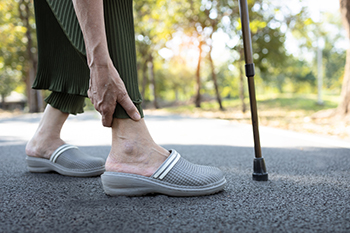
Athlete’s foot is a common condition that many people will develop at some point in their lives. It can be uncomfortable and causes itchiness and redness. The affected areas are the bottom of the foot and between the toes. The itching can become so severe that people often seek medical treatment for relief. It is caused by a fungus that can enter the body through tiny cracks in the skin. This fungus thrives in warm and moist environments, including public swimming pools, shower room floors, and similar areas. It is beneficial to wear appropriate shoes in these areas, such as flip-flops or water shoes, which are sufficient to protect the soles of the feet. People who have sweaty feet, poor circulation, or a weakened immune system may be prone to getting athlete’s foot. Temporary relief may be found by applying over-the-counter creams. If you have developed athlete’s foot, it is strongly suggested that you visit a podiatrist who can prescribe medication as a permanent treatment method.
Athlete’s foot is an inconvenient condition that can be easily reduced with the proper treatment. If you have any concerns about your feet and ankles, contact one of our doctors from New England Foot & Ankle . Our doctors will treat your foot and ankle needs.
Athlete’s Foot: The Sole Story
Athlete's foot, also known as tinea pedis, can be an extremely contagious foot infection. It is commonly contracted in public changing areas and bathrooms, dormitory style living quarters, around locker rooms and public swimming pools, or anywhere your feet often come into contact with other people.
Solutions to Combat Athlete’s Foot
- Hydrate your feet by using lotion
- Exfoliate
- Buff off nails
- Use of anti-fungal products
- Examine your feet and visit your doctor if any suspicious blisters or cuts develop
Athlete’s foot can cause many irritating symptoms such as dry and flaking skin, itching, and redness. Some more severe symptoms can include bleeding and cracked skin, intense itching and burning, and even pain when walking. In the worst cases, Athlete’s foot can cause blistering as well. Speak to your podiatrist for a better understanding of the different causes of Athlete’s foot, as well as help in determining which treatment options are best for you.
If you have any questions please feel free to contact our offices located in Wakefield, MA, Nashua and Derry, NH . We offer the newest diagnostic and treatment technologies for all your foot and ankle needs.



